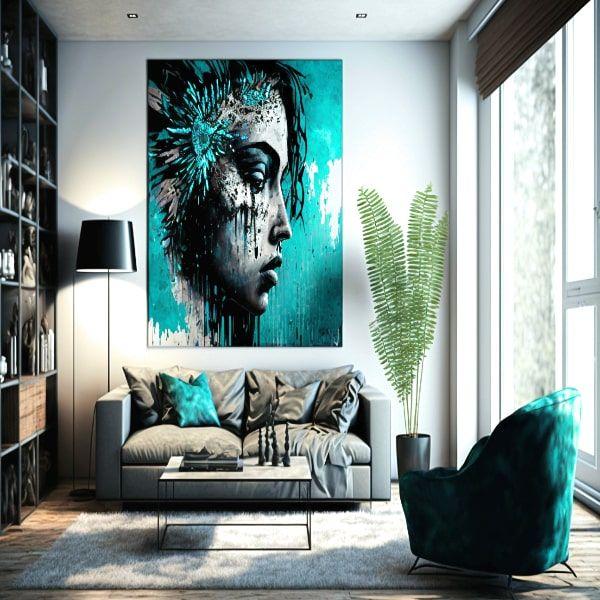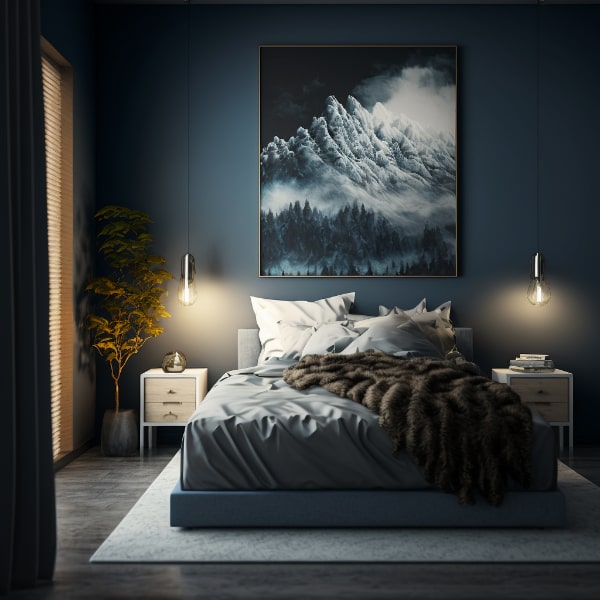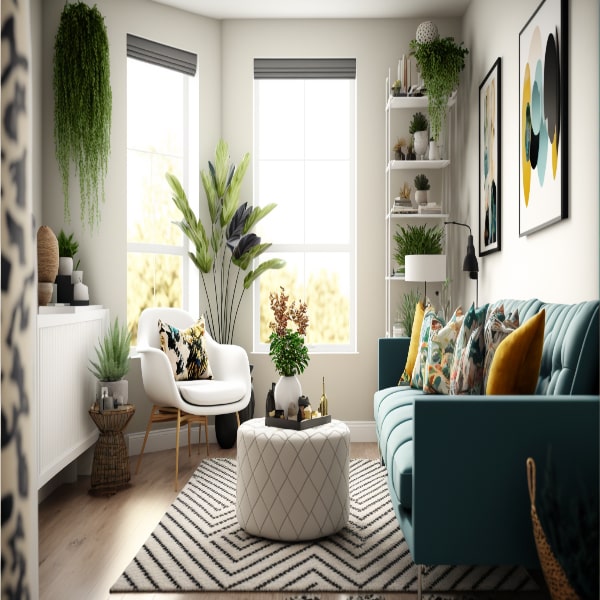Decorating your home can be an exciting but overwhelming task, especially when it comes to choosing the right colors, patterns, and textures that will give your space the perfect look and feel. A mood board is an excellent tool that can help you visualize your ideas and create a cohesive design concept. In this article, we will show you how to create a mood board on Pinterest for any room in your home.
Table of Contents
Introduction to Pinterest and Mood Boards
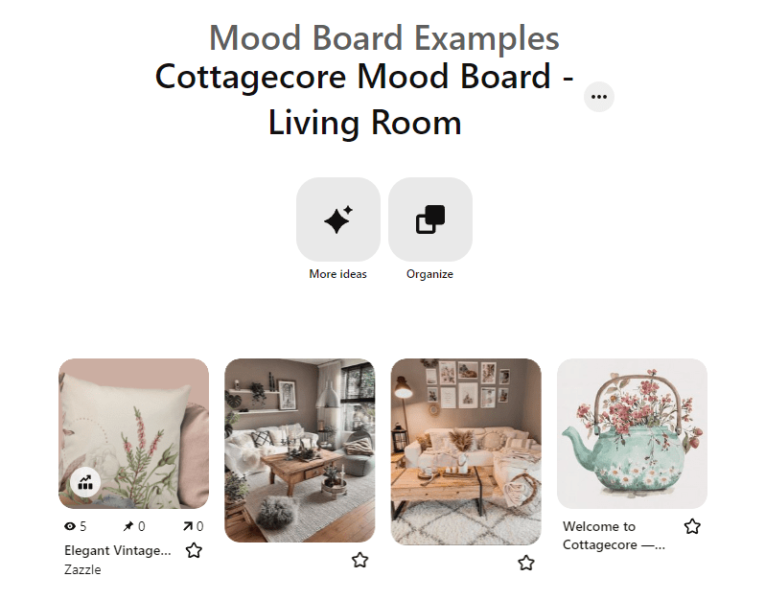
Pinterest is a social media platform/image search engine that allows users to share and discover images and videos on a virtual pinboard. It is a powerful tool for home decor enthusiasts who want to collect and organize ideas and inspiration from various sources. A mood board, on the other hand, is a visual representation of a design concept that includes images, colors, patterns, and textures that convey a particular mood or style. It can help you clarify your ideas, set the tone for your project, and communicate your vision to others.
To create a mood board on Pinterest, you will first need to create an account and a board dedicated to your home decor project. Here are the steps:
- Go to www.pinterest.com and click on the “Sign up” button to create a new account.
- Choose your preferred sign-up method (email, Google, or Facebook), and follow the prompts to set up your profile.
- Once you have created your account, click on the “+” icon at the top right corner of the screen, and select “Create board” from the drop-down menu.
- Give your board a descriptive name, such as “Living Room Makeover” or “Bohemian Bedroom Inspiration,” and add a brief description to explain the purpose of the board.
- Choose a category for your board, such as “Home Decor” or “Interior Design,” to make it easier for other users to discover and follow your content.
- Set the board to “Public” if you want to share it with others or “Secret” if you prefer to keep it private.
- Click on the “Create” button to finalize your board.
What Should be Included in a Mood Board?
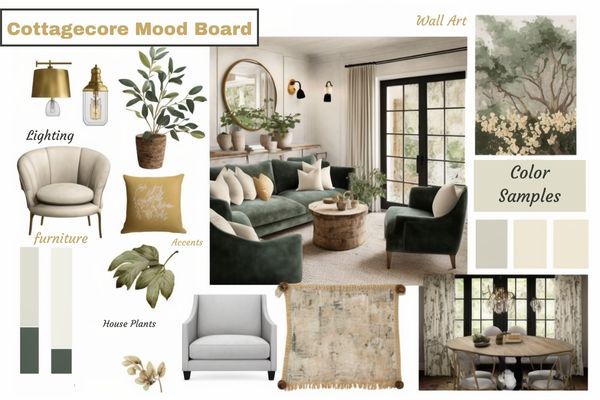
A mood board will typically feature an image of the desired style as a central point on the board, the rest of the images will make up the components of that image. For instance, you might choose a living room look that you like and images of the items in that room that are similar that could be used to recreate the look. Typically this would include some statement furniture pieces, some accent ideas such as throw pillows, lighting, a color scheme, house plants, and textured items such as rugs and curtains. The images dont have to match the main idea image, but instead compliment the overall aesthetic so that you can see at a glance how the color scheme works.
How Many Pictures Should a Mood Board Have?
Around ten images is usually enough to get a great idea of the overall mood you are trying to create. You can always add more if you wish but too many might make it difficult to choose. This again will depend on the style you have chose, ten images might be enough for a minimalist look, but if you are going for a maxamilist or ecclectic mood you may want many more.
Finding Inspiration: Searching and Saving Pins
Now that you have created your Pinterest account and board, it’s time to start searching for inspiration and saving pins that match your design concept. Here are some tips:
- Use the search bar at the top of the screen to enter keywords related to your project, such as “modern living room,” “rustic bedroom,” or “Scandinavian decor.”
- Refine your search by using filters, such as color, style, or room type, to narrow down the results.
- Browse through the pins that match your criteria and save the ones that catch your eye by clicking on the red “Save” button.
- Organize your pins by adding them to specific sections within your board. For example, you can create sections for furniture, lighting, textiles, and accessories.
- Add your own pins by uploading images or saving them from other websites. This will help you personalize your mood board and include items that may not be available on Pinterest.
- Follow other users and boards that share similar interests to discover new ideas and get inspiration.
Creating Your Mood Board: Arranging and Editing Pins

Once you have collected a substantial number of pins, it’s time to arrange them into a mood board that reflects your design concept. Here are some tips:
- Start by selecting a few key pins that represent the overall mood or style you want to achieve. These pins will serve as the foundation of your mood board. A good idea is to choose one or two room visuals and then recreate that style with individual pins of the items in the room, or similar items that would suit the overall aesthetic.
- Use the “organise” tool to drag and drop your pins onto the board and arrange them in a way that makes sense to you. If you have a lot of images you might want to create sections for each room. You can see an example of a section on our cottagecore mood board on pinterest.
- Experiment with different color schemes and patterns by placing pins next to each other and seeing how they interact. You can use the “Edit” tool to crop, resize, or rotate your pins to fit your design concept.
- Add text or captions to your pins to provide additional context or notes for yourself or others who may view your mood board.
- Use the “Share” button to invite other users to collaborate on your board or get feedback on your design concept.
More Tips on How to Create a Mood Board on Pinterest
- Be specific about your goals: Before you start searching for inspiration on Pinterest, it’s important to have a clear idea of what you want to achieve. Are you looking to create a cozy and comfortable space, a sleek and modern look, or a colorful and eclectic vibe? By setting specific goals, you can focus your search and avoid getting overwhelmed by too many options.
- Use Pinterest as a research tool: In addition to finding inspiration, Pinterest can also be a valuable research tool for home decor projects. You can use it to compare prices, read product reviews, and get ideas for DIY projects and upcycling.
- Think beyond aesthetics: While it’s important to choose pins that reflect your personal style and taste, don’t forget to consider practical factors such as functionality, durability, and safety. Make sure that the items you include in your mood board are not only beautiful but also functional and safe for your family and pets.
- Don’t be afraid to mix and match: One of the benefits of creating a mood board is that you can experiment with different styles and colors without committing to any particular look. Don’t be afraid to mix and match patterns, textures, and colors to create a unique and personalized space.
- Get feedback from others: Once you have created your mood board, it can be helpful to get feedback from others, such as friends, family, or a professional designer. They can offer suggestions and ideas that you may not have considered, and help you refine your design concept.
Mood Board Inspiration Table – Choosing a Style for your Mood Board
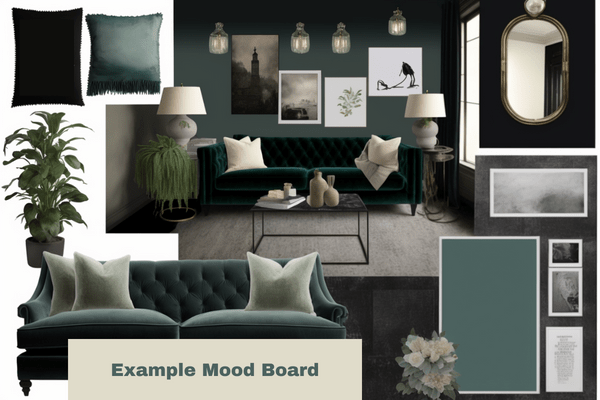
Not sure which style you want to use? The table below give a general guideline to the different styles you could try out for your own pinterest mood board. These are just basic themes, you can always mix and match, for example you might want a modern minimalist boho look, to achieve this you could choose complimentary colors from both color schemes and mix the minimalist style with a few prominent statement boho pieces.
| Room | Style | Color Scheme | Texture | Trend History |
|---|---|---|---|---|
| Living Room | Modern minimalist | Neutral (white, gray, black) | Leather, velvet, metallic | The 2010s saw a rise in modern minimalism, featuring clean lines, neutral colors, and natural materials. The 2020s continue this trend, with a focus on comfort and sustainability. |
| Bohemian | Warm (rust, mustard, terracotta) | Textured, patterned, layered | Bohemian style, also known as boho, has been around since the 19th century and features eclectic patterns, natural materials, and vintage finds. It continues to be a popular trend in the 2020s. | |
| Dining Room | Rustic | Earthy (brown, green, beige) | Wood, stone, woven | Rustic style has its roots in the countryside, featuring natural textures and colors. It gained popularity in the 1990s and continues to be a timeless trend. |
| Modern farmhouse | Neutral (white, black, gray) | Linen, burlap, galvanized metal | Modern farmhouse style combines clean, modern lines with rustic, natural elements. It gained popularity in the 2010s and continues to be a popular trend in the 2020s. | |
| Kitchen | Scandinavian | Neutral (white, gray, blue) | Natural wood, marble, ceramic | Scandinavian style originated in the 1950s in Nordic countries, featuring simple, functional designs and natural materials. It gained popularity in the 2010s and continues to be a timeless trend. |
| Industrial | Bold (black, gray, metallic) | Exposed brick, concrete, metal | Industrial style emerged in the 1970s, featuring raw, unfinished materials and a utilitarian aesthetic. It gained popularity in the 2010s and continues to be a popular trend. | |
| Bedroom | Romantic | Soft (pink, lavender, ivory) | Silk, lace, velvet | Romantic style has been around since the 18th century and features soft, feminine elements like ruffles, lace, and floral patterns. It continues to be a timeless trend. |
| Mid-century modern | Vibrant (teal, orange, yellow) | Walnut, teak, leather | Mid-century modern style originated in the 1940s and features clean lines, bold colors, and natural materials. It gained popularity in the 2010s and continues to be a popular trend. | |
| Bathroom | Coastal | Cool (blue, green, white) | Seashells, pebbles, glass | Coastal style reflects the relaxed, breezy atmosphere of the seaside, featuring cool, watery colors and natural elements like shells and driftwood. It gained popularity in the 1990s and continues to be a popular trend. |
| Spa-like | Calm (white, beige, gray) | Bamboo, stone, cotton | Spa-like style creates a calming, Zen-like atmosphere, featuring natural materials and colors that promote relaxation and tranquility. It gained popularity in the 2000s and continues to be a popular trend. | |
| Home Office | Minimalist | Neutral (white, black, gray) | Smooth, clean, simple | Minimalist style is all about reducing clutter and focusing on the essentials. It gained popularity in the 1960s and continues to be a popular trend in the 2020s, reflecting the need for simplicity and organization in our fast-paced, digital world. |
| Eclectic | Vibrant (multi-color) | Mix of textures and patterns | Mix of textures and patterns | Eclectic style is all about mixing and matching different styles, colors, and textures to create a unique and personalized look. It gained popularity in the 1970s and continues to be a popular trend in the 2020s, reflecting our desire for individuality and self-expression. | |
| Kid’s Room | Playful | Bright (rainbow, pastels) | Furry, textured, patterned | Playful style is all about creating a fun and imaginative space for kids to explore and grow. It gained popularity in the 1980s and continues to be a popular trend in the 2020s, reflecting the importance of play and creativity in childhood development. |
| Scandi-inspired | Neutral (white, gray, beige) | Wood, felt, wool | Scandi-inspired style for kids’ rooms reflects the same clean, functional design principles as Scandinavian style for adults. It gained popularity in the 2010s and continues to be a popular trend in the 2020s, reflecting our desire for simplicity and minimalism in our homes. | |
| Outdoor Living | Mediterranean | Warm (terracotta, blue, green) | Wrought iron, tile, stucco | Mediterranean style reflects the warm, sunny climate and relaxed lifestyle of the Mediterranean region, featuring colorful tiles, wrought iron accents, and lush greenery. It gained popularity in the 1920s and continues to be a popular trend in the 2020s, reflecting our love of outdoor living and entertaining. |
| Modern | Neutral (gray, white, black) | Wicker, metal, concrete | Modern outdoor style features clean, simple lines and materials that are durable and weather-resistant. It gained popularity in the 2010s and continues to be a popular trend in the 2020s, reflecting our desire for stylish, low-maintenance outdoor spaces. |
Creating a home decor mood board on Pinterest can be a fun and effective way to visualize your design ideas and create a cohesive look for your space. By following these simple steps, you can find and save inspiration, organize your pins into sections, and arrange them into a mood board that reflects your style and mood.
Mood boards can be a lot of fun to create, hopefully this guide will help you to create your own mood board on pinterest.
Thanks for reading! I hope you found this article helpful. If you did, please follow me on Pinterest for more decor inspiration
